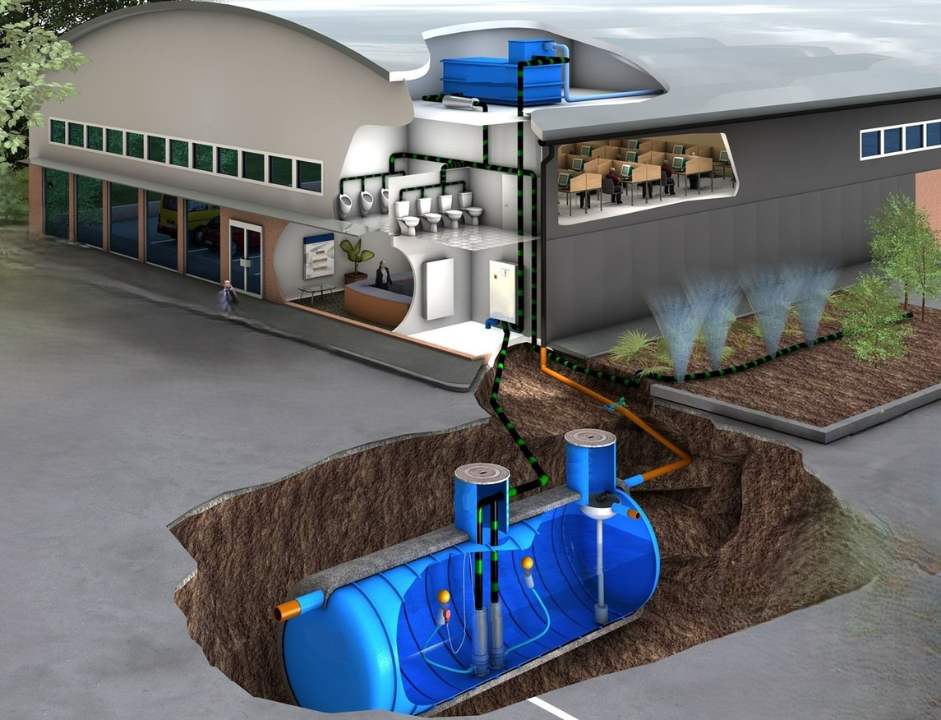Rainwater Harvesting Plant

Rainwater harvesting is a sustainable water conservation technique that involves collecting and storing rainwater for future use. This practice helps in reducing dependency on groundwater and municipal water supply, making it an essential solution for water-scarce regions. A well-designed rainwater harvesting system efficiently captures rainwater, filters it, and stores it for various applications like irrigation, industrial use, and even potable water supply.
A Rainwater Harvesting Plant is a structured system that integrates multiple components to ensure effective rainwater collection and utilization. These plants can be installed in residential, commercial, and industrial setups to promote water sustainability. Kelvin Water Technologies, a leading rainwater harvesting plant manufacturer, provides high-quality systems tailored to meet diverse requirements.
Key Components of a Rainwater Harvesting Plant
A rainwater harvesting plant consists of several essential components that ensure efficient rainwater collection, filtration, and storage. Below are the key components:
1. Catchment Area
The catchment area is the surface where rainwater is collected. It can be rooftops, terraces, open fields, or any impermeable surface that facilitates water runoff. The quality and efficiency of the rainwater harvesting system depend on the type of catchment area used.
- Types of Catchment Areas:
- Roof Catchments: Common in residential and commercial buildings, roofs made of metal sheets, tiles, or concrete are ideal for rainwater collection.
- Land Surface Catchments: Open spaces like gardens and courtyards can also be used for collecting rainwater.
- Rock Catchments: Natural rock formations help in channelling rainwater into reservoirs or collection tanks.
2. Gutters and Downpipes
Gutters and downpipes are essential for directing rainwater from the catchment area to the storage system. These components should be properly designed to prevent leakage and contamination.
- Material Used: Gutters are usually made of PVC, galvanized iron, or stainless steel to ensure durability and prevent corrosion.
- Proper Slope and Size: Ensuring the correct slope in gutters prevents water stagnation and allows smooth flow into the storage tanks.
3. Filtration System
A proper filtration system is critical for ensuring that the collected rainwater is free from impurities, debris, and contaminants.
Types of Filters:
- Mesh Filters: Prevents leaves and large debris from entering the storage system.
- Sand and Gravel Filters: Used to remove fine particles and sedimentation.
- Activated Carbon Filters: Helps in removing organic contaminants and improving water quality.
- UV Sterilization: Used in advanced rainwater harvesting systems for potable water treatment.
4. Storage Tanks or Reservoirs
Storage tanks hold the filtered rainwater for future use. The selection of storage tanks depends on factors like the volume of water to be stored, available space, and budget.
Types of Storage Tanks:
- Overhead Tanks: Installed above ground for easy access and distribution.
- Underground Tanks: Ideal for large-scale storage, protecting water from evaporation and contamination.
- Modular Storage Units: Used in commercial and industrial Rainwater Harvesting Plants to store large volumes efficiently.
5. Distribution System
The distribution system ensures that the harvested rainwater reaches the intended points of use. It consists of pumps, pipelines, and outlets that channel water for different purposes.
Pump Types:
- Gravity-fed Systems: Suitable for locations with elevation differences.
- Motorized Pumps: Used for lifting water in urban and industrial rainwater harvesting systems.
6. Recharge Structures
Recharge structures help in replenishing groundwater by allowing filtered rainwater to percolate into the soil.
Types of Recharge Structures:
- Recharge Pits: Simple pits filled with gravel and sand to aid in groundwater recharge.
- Percolation Ponds: Used in agricultural and industrial areas for large-scale groundwater replenishment.
- Recharge Wells: Directly inject water into underground aquifers for long-term conservation.
Benefits of a Rainwater Harvesting Plant
Installing a rainwater harvesting plant offers numerous benefits, making it an essential investment for residential, commercial, and industrial applications.
1. Water Conservation
A well-implemented rainwater harvesting system significantly reduces the demand for municipal and groundwater supplies, conserving natural water resources.
2. Cost Savings
By using harvested rainwater for non-potable applications like irrigation, flushing, and industrial cooling, water bills can be reduced considerably.
3. Reduces Urban Flooding
Rainwater harvesting minimizes surface runoff, preventing waterlogging and reducing urban flooding risks.
4. Improves Groundwater Levels
Recharge structures in rainwater harvesting plants aid in replenishing groundwater, improving water table levels in areas facing depletion.
5. Eco-Friendly Solution
Rainwater harvesting reduces dependency on treated municipal water, promoting sustainable water management and reducing carbon footprints.
6. Reliable Water Source
During droughts and water shortages, stored rainwater acts as an alternative water source, ensuring an uninterrupted supply.
7. Enhances Soil Quality
Using rainwater for irrigation improves soil quality as it is free from chemicals and salts, enhancing plant growth.
Conclusion
A rainwater harvesting plant is an effective and sustainable solution to combat water scarcity, reduce dependency on conventional water sources, and promote environmental conservation. With essential components like catchment areas, filtration systems, storage tanks, and recharge structures, these systems efficiently collect, store, and distribute rainwater for various applications.
KWTPL, a trusted rainwater harvesting plant manufacturer, provides customized solutions to meet diverse residential, commercial, and industrial water conservation needs. Investing in a rainwater harvesting system not only ensures water security but also contributes to a greener and more sustainable future.
For expert guidance and high-quality rainwater harvesting solutions, contact Kelvin Water Technologies today!